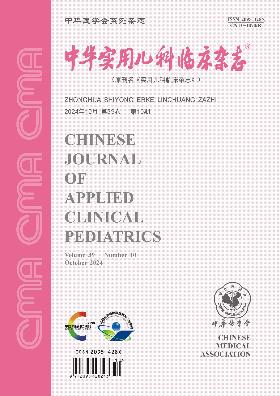A prospective multicenter randomized controlled study on the efficacy and safety of pharyngeal spraying recombinant human interferon alpha 2b in the treatment of children with herpangina
Q4 Medicine
引用次数: 0
Abstract
Objective To evaluate the efficacy and safety of pharyngeal spraying recombinant human interfe-ron alpha 2b (rhIFNα2b) in the treatment of herpangina in children. Method s A prospective, multicenter, rando-mized, opened and controlled study was carried out in 11 hospitals in Anhui province from August 2018 to March 2019.According to the time of admission, 180 patients diagnosed as herpangina were prospectively and randomly divided into rhIFNα2b treatment group and Ribavirin control group.On the basis of giving both groups the heat-clearing, detoxifying and anti-infection treatment, the patients in treatment group received pharyngeal spraying rhIFNα2b 9 g/L saline solution[1 million IU/mL, 0.1 million IU/(0.1 mL·press)], and the patients in control group were treated by pharyngeal spraying Ribavirin (0.5 mg RBV/press, 150 press), 3 presses per time, 4 times per day, continuous administration for 5 days for both groups.Those who recovered in advance were no longer given medication.All patients were observed to fully recover.The clinical efficacy and the disappearing time of symptoms and signs between two groups were compared, and the safety of pharyngeal spraying rhIFNα2b for patients was evaluated. Result s All of the 180 patients completed the study, including 90 cases in the treatment group and 90 cases in the control group.There was no statistically significant difference in terms of gender, age, weight and course of illness before treatment between the two groups (all P>0.05), which had clinical comparability.The apparent efficiency of the treatment group [63.3% (57/90 cases)] was significantly higher than that in the control group [38.9% (35/90 cases)] and the difference was statistically significant(χ2=10.934, P=0.004); no significant difference in the total efficiency between the treatment group [96.7% (87/90 cases)]and the control group [92.2% (83/90 cases)]was observed (χ2=2.924, P=0.169). The duration of fever[(32.59±20.73) h vs.(45.72±26.96) h], hyperemia[(76.48±23.12) h vs.(92.44±24.31) h], herpes[(72.99±25.77) h vs.(85.09± 26.62) h], salivation[(45.44±24.96) h vs.(54.42±31.20) h] and anorexia[(62.70±23.99) h vs.(78.71±30.54) h] in the treatment group were significantly shorter than those in the control group, and the differences were statistically significant(all P 0.05). After treatment, the serum levels of TNF-α and IL-6 were(7.26±1.99) ng/L and (2.42±0.73) ng/L in the treatment group, which were significantly lower than those in the control group [(12.09±6.39) ng/L and (7.32±11.51) ng/L](all P 0.05). The comparison on positive rate of virus in pharyngeal swab between the treatment group [65.3% (32/49 cases) and 40.6% (13/32 cases) respectively] and the control group[66.7%(36/54 cases) and 41.0% (16/39 cases), respectively]before and after therapy showed no significant difference (all P>0.05). During the treatment, no serious adverse reactions were observed in the two groups.The incidence of adverse reactions was 1.1% (1/90 cases) in the treatment group and 5.6% (5/90 cases) in the control group.In addition, the serum hemoglobin level of children in the control group after treatment was significantly lower than that before treatment and that in the treatment group (all P<0.05). Conclusions Compared with pharyngeal spraying ribavirin, pharyngeal spraying rhIFNα2b can greatly improve the clinical efficiency, accelerate the disappearance of clinical symptoms and signs, and shorten the total course of disease, and is more safe and worthy of clinical application. Key words: Herpangina; Recombinant human interferon alpha 2b; Ribavirin; Pharyngeal spraying一项咽部喷药重组人α 2b干扰素治疗疱疹性咽峡炎患儿疗效和安全性的前瞻性多中心随机对照研究
目的评价重组人干扰素α2b (rhIFNα2b)咽喷剂治疗儿童疱疹性咽峡炎的疗效和安全性。方法2018年8月至2019年3月在安徽省11家医院开展前瞻性、多中心、随机、开放、对照研究。根据入院时间,将180例确诊为疱疹性咽峡炎患者前瞻性随机分为rhIFNα2b治疗组和利巴韦林对照组。在给予两组清热解毒抗感染治疗的基础上,治疗组患者给予rhIFNα2b咽喷9 g/L生理盐水溶液[100万IU/mL, 10万IU/(0.1 mL·按压)],对照组患者给予利巴韦林咽喷(0.5 mg RBV/按压,150按压),每次3按压,每天4次,两组连续给药5 d。那些提前康复的患者不再接受药物治疗。所有患者均完全康复。比较两组患者的临床疗效及症状体征消失时间,并评价咽部喷雾剂rhIFNα2b对患者的安全性。结果180例患者全部完成研究,其中治疗组90例,对照组90例。两组患者在性别、年龄、体重、治疗前病程等方面差异均无统计学意义(P < 0.05),具有临床可比性。治疗组的表观有效率[63.3%(57/90例)]显著高于对照组[38.9%(35/90例)],差异有统计学意义(χ2=10.934, P=0.004);治疗组总有效率[96.7%(87/90例)]与对照组[92.2%(83/90例)]比较,差异无统计学意义(χ2=2.924, P=0.169)。治疗组发热持续时间[(32.59±20.73)h比(45.72±26.96)h]、充血持续时间[(76.48±23.12)h比(92.44±24.31)h]、疱疹持续时间[(72.99±25.77)h比(85.09±26.62)h]、流涎持续时间[(45.44±24.96)h比(54.42±31.20)h]、厌食持续时间[(62.70±23.99)h比(78.71±30.54)h]均显著短于对照组,差异均有统计学意义(P均0.05)。治疗后,治疗组血清TNF-α和IL-6水平分别为(7.26±1.99)ng/L和(2.42±0.73)ng/L,显著低于对照组[(12.09±6.39)ng/L和(7.32±11.51)ng/L](均P 0.05)。治疗组治疗前后咽拭子病毒阳性率分别为65.3%(32/49例)和40.6%(13/32例),对照组分别为66.7%(36/54例)和41.0%(16/39例),两组比较差异无统计学意义(P < 0.05)。治疗过程中,两组患者均未见严重不良反应。治疗组不良反应发生率为1.1%(1/90例),对照组为5.6%(5/90例)。对照组患儿治疗后血清血红蛋白水平显著低于治疗前和治疗组(均P<0.05)。结论与咽部喷药利巴韦林相比,咽部喷药rhIFNα2b可显著提高临床疗效,加速临床症状体征消失,缩短总病程,安全性更高,值得临床推广应用。关键词:疱疹性咽峡炎;重组人干扰素α 2b;利巴韦林;咽喷涂
本文章由计算机程序翻译,如有差异,请以英文原文为准。
求助全文
约1分钟内获得全文
求助全文
来源期刊

中华实用儿科临床杂志
Medicine-Pediatrics, Perinatology and Child Health
CiteScore
0.60
自引率
0.00%
发文量
14243
期刊介绍:
Chinese Journal of Applied Clinical Pediatrics ( semi-monthly ) is a core journal of paediatrics under the supervision of China Association for Science and Technology, sponsored by Chinese Medical Association and undertaken by Xinxiang Medical College. Founded in 1986, it is openly circulated both at home and abroad. The journal has several columns, such as Expert Forum, Experimental Research and Paediatric Surgery, which are mainly for paediatric medical workers and medical researchers in hospitals. Its purpose is to reflect the new theories and technologies in paediatric medicine and scientific research at home and abroad, and to promote academic exchanges.
Chinese Journal of Applied Clinical Pediatrics is a source journal of China Science Citation Database (CSCD), a core journal of Peking University, a source journal of Chinese science and technology paper statistics (China Science and Technology Core Journals), a core academic journal of RCCSE, a high-quality scientific and technical journal of China, a high-quality scientific and technical journal of China Association for Science and Technology, and a high-quality scientific and technical journal of China Biomedical Science and Technology Association. We have been published in China Biomedical Literature Database (SinoMed), China Knowledge Network, Wanfang Data Knowledge Service Platform, China Academic Journal Abstracts, Scopus Database, Chemical Abstracts (USA), Japan Science and Technology Agency (JSTA) Database, Copernicus Abstracts (Poland), Abstracts of the Centre for Agricultural and Biological Sciences (CABS) of the United Kingdom, Cambridge Scientific Abstracts ProQuest Database, WHO Medical Journal of the Western Pacific Region (WMPR), and WHO Medical Journal of the Western Pacific Region (WMPR) of the United States. We have been included in dozens of authoritative databases at home and abroad, such as WHO Western Pacific Region Index of Medicine (WPRIM), Ullrich's Guide to Periodicals, and so on.
 求助内容:
求助内容: 应助结果提醒方式:
应助结果提醒方式:


